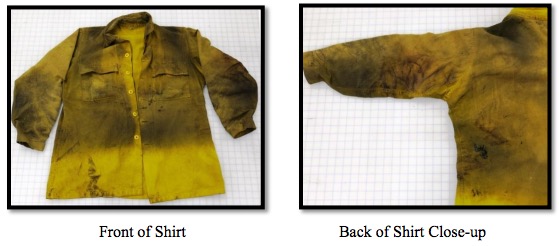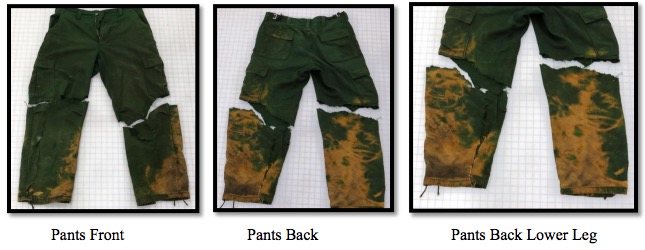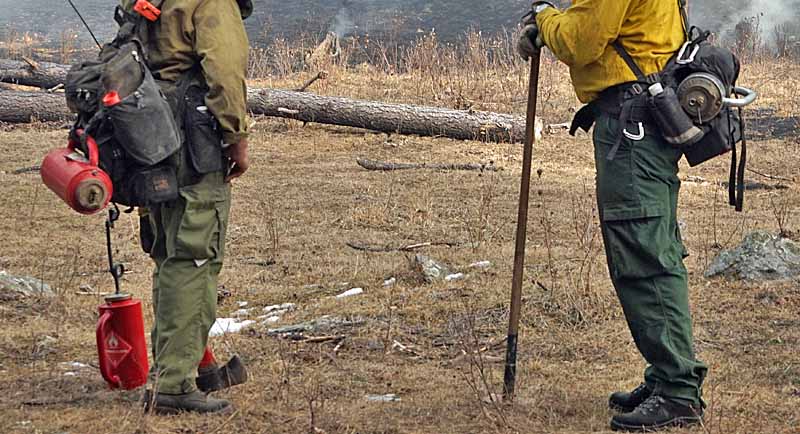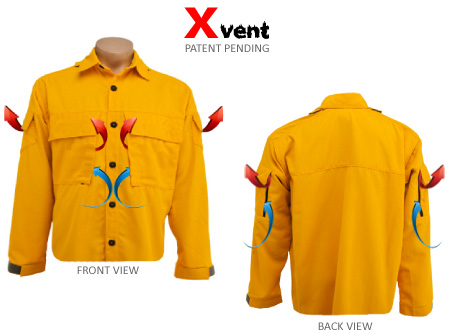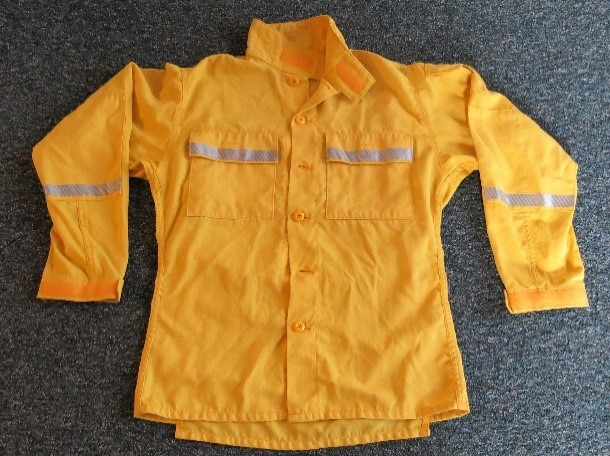
The National Wildfire Coordinating Group has approved a modification to the wildland firefighter shirt to add retroreflective striping on the arms and pocket flaps. In the article below written by Tony Petrilli, the U.S. Forest Service’s National Technology and Development (T&D) Program Project Leader for firefighter clothing, he explains that it will become available through the regular fire equipment system in one to two years. He also describes how they decided on the striping, rather than high visibility cloth for the entire shirt.
The article was published June 12, 2019 at the Wildland Fire Lessons Learned Center website.
High Visibility — More to the Story . . .
JUNE 12, 2019 / WILDFIRELESSONS
By Tony Petrilli
As the U.S. Forest Service’s National Technology and Development Program (T&D) Project Leader for firefighter clothing, I would like to address some of the history and decision-making criteria concerning Forest Service “spec” garments.
A recent Blog Post on this LLC site written by Charlie Palmer [https://wildfirelessons.wordpress.com/2019/04/16/high-vis/] referred to a proposal that he sent to us at the National Technology and Development Program four years ago requesting us to evaluate high visibility (HV) flame resistant (FR) garments. While this project proposal was rejected, most importantly, the concept was not. (Another Key Point: Project proposals to T&D are vetted through an interagency fire steering committee, not necessarily T&D itself.)
Many years ago, I asked FR fabric manufacturers here in the United States about HV. A couple years after that, one of the manufacturers had developed a new HV fabric.
Current Shirt
During the T&D firefighter shirt redesign project that resulted in the current (M2011) FS spec design, high visibility yellow color fabric was one of the many fabrics considered and was wear tested by firefighters in the field. Some resultant facts and findings:
- Flame resistant meta-aramid (Nomex IIIA) fabric does not bond well with high visibility colored dyes to American Society for Testing and Materials (ASTM) visibility standards.
- Flame resistant fabric made with modacrylic fibers can be dyed with HV colors.
- In order to meet the minimum radiant protective performance (RPP) requirements, modacrylic fabric needs to be heavier and thicker than current meta-aramid (Nomex IIIA) fabric.
- Wear test shirts made from HV modacrylic blend fabric received low ratings from firefighters in terms of heat stress and comfort due to lower air permeability and heavier weight of the fabric.
- Wear testers found that the high visibility dyes washed out with relatively few washings and leftover fire grime in the fabric left it rather dull and faded.
It seems most everything is a tradeoff in firefighter clothing. Balances therefore need to be scrutinized and discussed. Example: Garment/fabric radiant heat protection (from the fire) is very much inversely proportional to heat loss that is human generated. HV also comes with a tradeoff cost.
Decision
Firefighters run the risk of heat stress many days during a fire season. It was therefore decided that it was not worth increasing that risk (as slight as that may be) by wearing heavier/less breathable high visibility clothing. The traits of the normal yellow meta-aramid blend shirt was determined as the appropriate balance of all fabric qualities.
Any New Developments? Retroreflective Striping
Just last month, the NWCG Equipment Technology Committee agreed to a slight modification to the 2011 FS spec shirt design. The NWCG Risk Management Committee has also been briefed on this new revision. The shirt style has been wear-tested with firefighters in the field.
The biggest change is the addition of segmented *retroreflective striping. It is limited to placement on the pocket flaps and the bottom edge of the elbow patches due to the small possibility of stored energy burns and the lack of air permeability. Placing a limited amount of segmented striping will decrease the possibility of unintended outcomes yet is a practical step toward being more visible.
Depending on stocking levels, the new revision of shirts will arrive in orders within a year or two.
In a few years, when the Product Review Life Cycle brings back the shirt project, high visibility fabric and other new technology with potential benefits will once again be considered. This year we are starting a project review for firefighter pants. Be looking for a product questionnaire coming out soon!
Any agency or department can perform their own Risk Assessment and Trade-Off Analysis. If the need for excellent high visibility qualities (instead of the very good qualities of a clean yellow shirt) outweigh the need for excellent heat loss and air permeability, investigate private vendors that sell HV garments. For buyer protection, make sure the garment label confirms certification to NFPA 1977.
Until New Shirts with Reflective Striping Arrive, What Can We Do to Optimize Firefighter Visibility with the Current Clothing?
- Many firefighters carry signal mirrors that coincidentally don’t work well in smoky and cloudy conditions or in the dark. Consider replacing or supplementing that signal mirror with a small (size of a marker) strobe flashlight. Some folks have reported that these flashlights are very effective. (See this “New Signaling Tools” RLS.)
- Trade in dirty clothing at incident Supply Units or come to a fire with a couple clean sets in your red bag.
- Follow The Red Book Chapter 7 direction for permanently stained or old, faded shirts—replace them.
- Leave reflective striping intact on helmets and fireline packs.
Besides Visibility is Dirty PPE an Issue?
Besides the lack of visibility qualities, soiled garments have been shown to offer less radiant heat protection, be flammable (if gas and oil soiled), less breathable, and may contain toxins that are harmful to the wearer. Anecdotally, I have noticed less and less super-dirty firefighters while on assignments lately. Even so, firefighters need to be educated on this issue and supervisors need to take measures to ensure relatively clean garments are worn.
Currently, T&D is working with the National Institute for Occupational Safety and Health (NIOSH) to test real-world soiled firefighter clothing for such potential hazards, then determine the risk as well as the appropriate cleaning practices.

Many firefighters don’t want to be visible. They feel clean clothes and reflective striping somehow makes them look uncool. They subscribe to LCES—“Look Cool Every Second”. (Sorry, Paul G.) If someone gives you grief for wearing a clean or new looking shirt, tell them you wore out your old one. By the way, my son did not give me grief for being clean, he knows better than that. He did, however, say that I look good!
Comments or questions? Feel free to contact me at anthony.petrilli@usda.gov or 406-329-3965.
*Note from Bill: According to Reflectivetapeinfo, “The word “retro” is the key to understanding the difference between a reflective surface like a mirror, and a retro reflective surface like a bike or automobile reflector. Retro means to go back or backward. In the reflective tape industry it means to return light back where it came from and no where else.”

